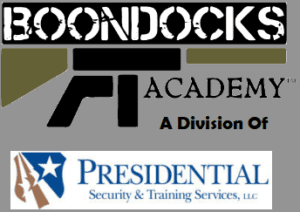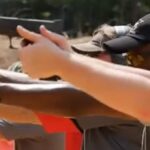7 Things You Probably Didn’t Learn in Your Concealed Carry Course, But Need to Know!
The Concealed Carry Revolution began in the late 1990’s. A combination of rising crime rates and the easing of concealed carry restrictions led millions of Americans to apply and get their Concealed Carry Permits. According to the Crime Prevention Research Center there were “2.7 million concealed handgun permit holders in 1999, 4.6 million in 2007, 8 million in 2011, 11.1 million in 2014, and 19.48 million in 2020.” Combine those numbers with the National Shooting Sports Foundations (NSSF) estimate of an additional 8.4 million first time gun owners since March of 2020, and you begin to see that people are becoming increasingly concerned about being able to protect and defend themselves and their families. But is a gun, a permit and maybe a basic shooting class all you need to be prepared? Here are 7 must have skills to be better prepared to protect and defend yourself and your family.
1. Defensive Shooting Skills – Chances are if you took a class to get a concealed carry permit the shooting portion (if there was any at all) was probably very basic and focused more on marksmanship than Defensive Shooting Skills. Your course of fire probably included shooting 25-50 rounds on paper targets, at known distances, and under little to no stress or time constraints. However, if you are ever forced to fire on an attacker, you are going to need to shoot much faster. Shooting fast isn’t hard, but shooting fast while keeping all your shots on the target (or bad guy) is much more difficult and something many gun owners never practice. In fact, I would venture to say most gun owners would struggle to keep 5 rounds in a 5-inch circle at 5 yards even at a pace of 1 shot per second. So how fast should you be able to shoot? Dave Spaulding with Handgun Combatives suggests you should be able to shoot about 3 shots per second. That equates to a shot every .33 seconds or about the time it takes to blink. In order to become proficient shooting at this pace you have to mitigate recoil by utilizing a proper grip and stance, understand flash sight picture and learning to reset the trigger in recoil recovery. If you are unsure what these terms mean you should look into an intermediate level handgun course. If you would like to test your Defensive Shooting Skills feel free to download the 357 Drill. Start from the low ready and see if you can put 5 rounds in the 7″ circle from 5 yards in less than 5 seconds. Once you can do that, try moving up to the Basic and Intermediate Skill Levels indicated on the target.
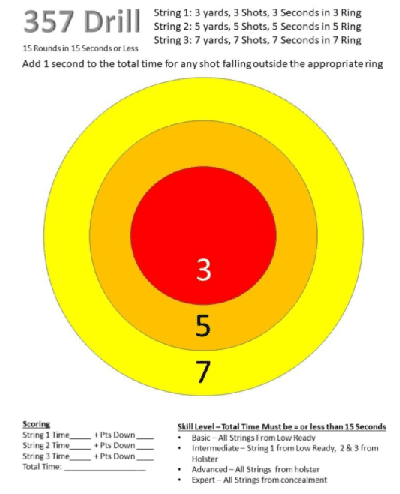
2. Situational Awareness and How to Avoid Becoming a Victim – If you have taken any kind of firearms training class that is worth its salt, you should have learned about Situational Awareness. The class may have also included a version of Colonel Jeff Cooper’s Color Codes of Awareness. While that is good information to have, it is usually a watered-down version of Cooper’s original intent. The Color Codes of Awareness discussed in many firearms training classes were originally used by the US Marines in World War II to help them prepare for a possible attack. This Color Code system was later modified by Col. Jeff Cooper to help educate civilians on the need to be aware of their surroundings, but more importantly to be mentally prepared to respond to a violent attack. The 4 Color Codes as used in most classes today are as follows:

Again, this isn’t bad information, but Situational Awareness means more than just looking around. If you want to avoid becoming a victim, you need to know how to spot potential bad guys, and how to avoid looking like an easy target to a violent criminal. The article entitled “How to Spot a Bad Guy” by Greg Ellifritz with Active Response Training gives a “Comprehensive Look at Body Language and Pre-Assault Indicators” and it is well worth your time to read.
3. Mentally and Physically Conditioned to Respond – In Colonel Cooper’s original version of the Color Codes, he also talked about mental preparedness. As moral law-abiding citizens, we can sometimes be shocked at the level of violence unleashed by some of society’s most heinous criminals. If we don’t practice and plan to respond mentally and physically, to violence, WITH violence, we may be hesitant to “pull the trigger” so to speak when our lives or the lives of our loved ones are on the line. For example, you may have created a home defense plan to deal with a home invasion, but have you physically practiced the plan and mentally prepared to shoot someone in your home? Have you imagined the alarm going off, grabbing your firearm and heading out of your bedroom (if necessary to secure other family members) and encountering a criminal in your home? Have you imagined and practiced spotlighting the bad guy from different areas of your home and seeing him raise his gun to fire at you, while you simultaneously raise yours and SHOOT? Have you tried to imagine the muzzle flash, the noise, the chaos and the screams? What if you are surprised and held at gunpoint while getting into or out of your car? Have you mentally considered what your “go signal” would be? When that “go signal” switch gets flipped, have you physically practiced and mentally prepared to simultaneously draw and get off the “X” and SHOOT? Have you pictured the bad guy turning and running while you move to seek cover? It is also important to note that not every situation is a “shoot situation”, so you should also mentally prepare to counter act in other ways including “hands on” (if you have the skill, see #5) or escaping if at all possible. I highly encourage you to take the time to watch this 25-minute video called “Col. Jeff Cooper: Mental Condition, Color Codes” in which he masterfully weaves his Color Codes with the aspects of both physical and mental conditioning.
4. The Aftermath of Use of Force – If you have taken a permit to carry class you may have been introduced to the carry laws and the laws of justifiable homicide for your state. Your class likely covered where you can and can’t carry your firearm and when you can and can’t use deadly force. However, this is usually the bare minimum required by law and doesn’t truly cover the full spectrum on the use of deadly force. I would venture to say your class probably didn’t cover topics such as Disparity of Force, Affirmative Defense, The AOJ Triad, etc. Not to mention what to say and not say to the police when they show up. Also, many classes don’t talk about the importance of having a legal plan in place or the many physiological or psychological issues after a deadly force encounter. If your class didn’t cover this, this should be your next area of study. I would highly encourage you to sign up for a Massad Ayoob Group MAG20 Armed Citizen’s Rules of Engagement (or MAG40 which includes a Live Fire Session, if you also want to knock out number 1 on this list). There are also some organizations that I would recommend to gain additional knowledge about the legal use of force as well as having a legal plan in place before you actually need it. Both the United States Concealed Carry Association (USCCA) and Armed Citizens Legal Defense Network (ACLDN) provide a level of education and protection. As part of a USCCA membership, there is over 20 hours of content on self-defense, deadly force and justifiable homicide, plus additional downloadable guides. ACLDN also offers a FREE downloadable book called “What Every Gun Owner Needs to Know About Self-Defense Law. You can also join the ACLDN for $135.00 and get access to funds to cover attorney and legal expenses after a self-defense incident. A USCCA members is slightly more expensive (Starting at $299 a year), but you get access to more education and training, plus $250,000 in Defense Expenses and $2,000,000 in “claims expenses and damages.” No other organization offers that level of coverage for Civil Cases. We work closely with both organizations and my personal recommendation is that you should at least belong to one (both if you can afford it) of the organizations. You can Join the USCCA by clicking here and using Code BOON or ACLDN by clicking here I would also encourage you to take the time to watch a great video interview from John Lovell with Andrew Branca on the importance of having both the physical education and training as well as the financial backing to protect yourself. In this video Andrews recommends both USCCA and ACLDN as well as CCW Safe, and while there isn’t anything wrong with CCW Safe (I was a CCW Safe Member many years ago), they are a more expensive option and have less overall benefits than USCCA.
5. Basic Life Saving Skills – For many serious concealed carriers out there, getting some Basic Life Saving (BLS) Skills is usually a natural progression. However, for those that take a Concealed Carry Class and don’t go on to truly adopt the personal protection mantra, a basic lifesaving class doesn’t even cross their mind. The truth is, you or someone you know, is much more likely to need some kind of first aid than to be a victim of a violent crime. Heart attack, stroke, heat exhaustion, choking, car wreck, allergic reactions, seizures, etc. are all much more common than being involved in a gun fight. Unfortunately, unless you are involved in an organization like Boy scouts or your company requires you to take CPR/AED classes, you likely won’t be able to render aid to someone when they need it most. Organizations such as the Red Cross and American Heart Association offer CPR/AED and First Aid classes, but it is also important to have the skills to apply a tourniquet or other blood loss control measures. In 2015 the Federal Government, in conjunction with The American College of Surgeons Committee on Trauma, launched the Stop The Bleed Campaign. It is an organization intended to help people become trained and equipped to help others during a bleeding emergency until professional help arrives. The USCCA also had a great program called Emergency First Aid Fundamentals. It includes all of the topics above and is one of the classes included in a USCCA Membership, or you can also purchase it online as an eLearning course or in book form.
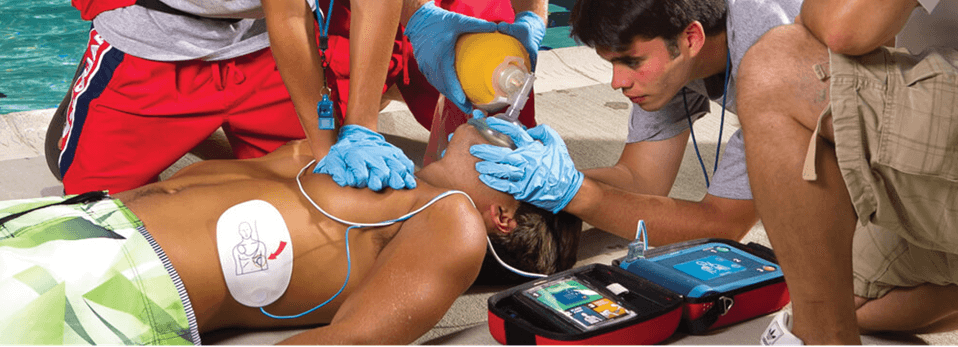
6. Basic Hand to Hand Skills – It is not possible to remain situationally aware and carry a gun at all times. There may be places where you cannot legally carry your gun, or even if you have your gun, you may be ambushed. For these reasons, serious self-defense shooters also tend to include some type of martial arts training. But you don’t have to be a black belt in Brazilian jiu-jitsu to be better prepared to protect yourself. Even just knowing how to fall without hitting your head on the concrete when shoved or falling backwards can be the difference between life and death. If you fall and are knocked out unconscious you are now at the mercy of the criminal who can do whatever they wish to you. So, at the very least a Basic Hand to Hand Class should include techniques on how to fall without injuring yourself, how to maintain distance while trying to get off the ground quickly and basic techniques to break away from someone that has gotten a hold of you. Another class that may be of benefit would be a weapons retention class and even a weapon of opportunity where you learn how to retain your firearm while in the midst of a hand-to-hand struggle and other tools that you can use to defend yourself if you don’t have a firearm.

7. Emergency Preparedness – Finally, an area that is becoming increasingly more important is being prepared to deal with emergencies. It may be a natural disaster such as a tornado, hurricane, earthquake or other severe weather event, a pandemic, or food shortages caused by panic buying or supply chain disruptions due to cyberattacks. Regardless of what the emergency is, having the ability to “weather the storm” by having a supply of food, water and medical needs means you can shelter in place for a period of time and avoid having to venture out into what might be a chaotic environment. At a minimum you should have about 30 days per family member worth of food and medicine on hand, and either an ample supply of water or a way to purify water. There are a ton of companies that have long term food storage and water purification options out there that can provide you and your family with enough calories to ride out the storm. One of the additional advantages to joining the USCCA is also an excellent online course called “Emergency Preparedness Fundamentals” that covers the “Four Pillars of Survival” including Water, Food, Shelter and Security and much more!
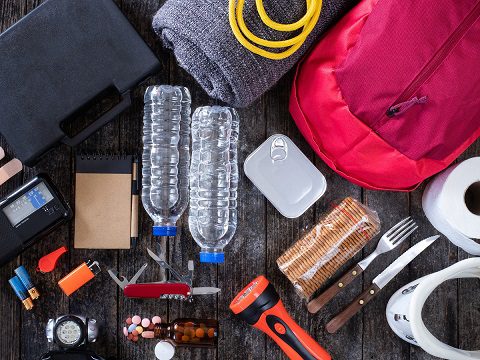
You may think that adding these skills to your repertoire will be expensive and time consuming, but simply dedicating a couple of days a year to take a training class (in any one of 6 areas) and adding in a couple of days of practice a year can make a huge difference. In a climate where we are increasingly seeing crises such as pandemics, riots, food, shortages, cyber attacks and an increased risk of terrorism, having the skills and resources to sustain and protect your family is priceless!
